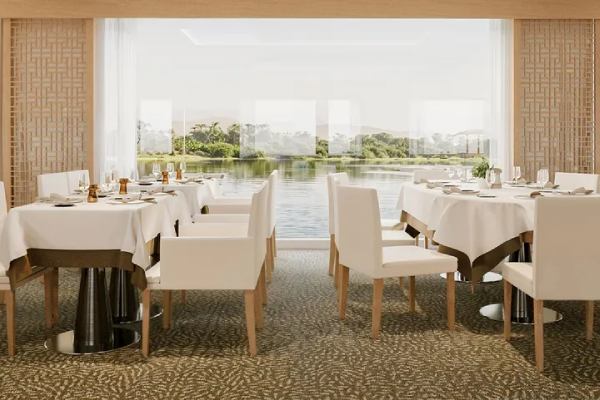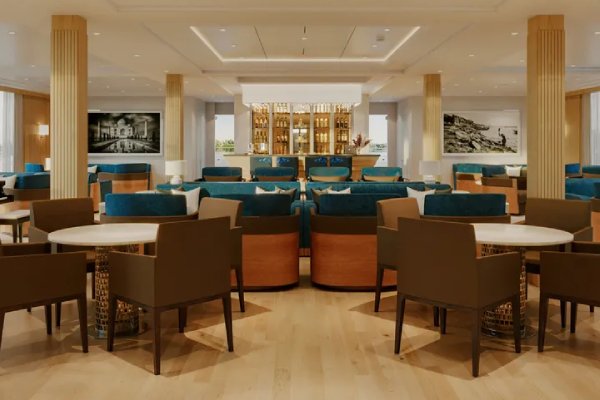14-night Wonders of India I Cruise/Land Package
Cruise Inclusions
- One complimentary shore excursion in every port of call
- Unlimited free Wi-Fi
- Visits to UNESCO Sites
- Enrichment lectures & Destination Performances
- Cultural Curriculum
- Meals including regional specialties
- Most alfresco dining on the rivers
- Welcome Cocktails & Farewell Dinner
- Beer, wine & soft drinks with onboard lunch & dinner
- 24-hour specialty coffees, teas & bottled water
- Walking track & sports deck
- Curated library
- 24-hour guest services
- All port taxes & fees
- Airport transfers on embarkation/disembarkation day with Viking Air purchase
- Viking Service Guarantee
- River-view stateroom Hotel-style bed with optional twin-bed configuration; luxury linens & pillows
- 40" flat-screen LCD TV with complimentary Movies On Demand
- 110/220 volt outlets & USB ports
- Refrigerator; security safe; hair dryer
- Spacious glass-enclosed shower
- Heated bathroom floor & anti-fog mirror
- Premium Freyja® toiletries; plush robes & slippers
- Stateroom steward & twice-daily housekeeping
Roundtrip Delhi
Delhi (New Delhi) •
12/25/2028
Delhi (New Delhi) •
12/26/2028
Agra •
12/27/2028
Agra •
12/28/2028
Jaipur •
12/29/2028
Jaipur •
12/30/2028
Guwahati •
12/31/2028
Guwahati •
1/1/2029
Brahmaputra River •
1/1/2029
Kaziranga National Park •
1/2/2029
Kaziranga National Park •
1/3/2029
Biswanath •
1/4/2029
Brahmaputra River •
1/4/2029
Majuli Island •
1/5/2029
Neamati Ghat •
1/6/2029
Neamati Ghat •
1/7/2029
Delhi (New Delhi) •
1/7/2029
Delhi (New Delhi) •
1/8/2029
Suite
 View Details
View Details

Explorer Suite
(ES)
- Category: ES
- Upper Deck
Stateroom size: 700 sq ft (includes private veranda). Features - River-view suite with spacious, separate sitting room & floor-to-ceiling sliding glass door opening to a large veranda off the living room, Queen-size Viking Explorer Bed (optional twin-bed configuration) with luxury linens & pillows, Wi-Fi (connection speed may vary), Flat-screen TV with infotainment system featuring a selection of live TV channels, Movies On Demand and in-house programming, Additional flat-screen TV in sitting room, 110/220 volt outlets & USB ports, Large private bathroom with spacious glass-enclosed shower, bathtub & anti-fog mirror, Plush robes & slippers, Telephone, safe, refrigerator, Individual climate control, Bottled water replenished daily, Welcome champagne; mini-bar with wine, beer & soft drinks (replenished daily); daily fruit plate, Binoculars, Personal coffee machine with premium coffee, Stateroom steward & twice-daily housekeeping, in-room breakfast service, laundry & shoe shine services, Silver Spirits beverage package included, Private arrival/departure transfer in destination, Under-bed suitcase storage space, Roomy wardrobe with wooden hangers.
Explorer Suite
(ES)
Call for Pricing
Balcony
 View Details
View Details

Veranda Stateroom
(C)
- Category: C
- Main Deck
Stateroom size: 264 sq ft (includes private veranda). Features - River-view stateroom with French balcony (floor-to-ceiling sliding glass door) & private veranda, Queen-size Viking Explorer Bed (optional twin-bed configuration) with luxury linens & pillows, Wi-Fi (connection speed may vary), Flat-screen TV with infotainment system featuring a selection of live TV channels, Movies On Demand and in-house programming, 110/220 volt outlets & USB ports, Private bathroom with spacious glass-enclosed shower, anti-fog mirror & hair dryer, Premium Freyja toiletries, Plush robes & slippers (upon request), Telephone, safe, refrigerator, Individual climate control, Bottled water replenished daily, Binoculars, Stateroom steward & twice-daily housekeeping, Under-bed suitcase storage space, Roomy wardrobe with wooden hangers.
Veranda Stateroom
(C)
Call for Pricing
 View Details
View Details

Veranda Stateroom
(B)
- Category: B
- Middle Deck
Stateroom size: 264 sq ft (includes private veranda). Features - River-view stateroom with French balcony (floor-to-ceiling sliding glass door) & private veranda, Queen-size Viking Explorer Bed (optional twin-bed configuration) with luxury linens & pillows, Wi-Fi (connection speed may vary), Flat-screen TV with infotainment system featuring a selection of live TV channels, Movies On Demand and in-house programming, 110/220 volt outlets & USB ports, Private bathroom with spacious glass-enclosed shower, anti-fog mirror & hair dryer, Premium Freyja toiletries, Plush robes & slippers (upon request), Telephone, safe, refrigerator, Individual climate control, Bottled water replenished daily, Binoculars, Stateroom steward & twice-daily housekeeping, Under-bed suitcase storage space, Roomy wardrobe with wooden hangers.
Veranda Stateroom
(B)
Call for Pricing
 View Details
View Details

Veranda Stateroom
(A)
- Category: A
- Upper Deck
Stateroom size: 264 sq ft (includes private veranda). Features - River-view stateroom with French balcony (floor-to-ceiling sliding glass door) & private veranda, Queen-size Viking Explorer Bed (optional twin-bed configuration) with luxury linens & pillows, Wi-Fi (connection speed may vary), Flat-screen TV with infotainment system featuring a selection of live TV channels, Movies On Demand and in-house programming, 110/220 volt outlets & USB ports, Private bathroom with spacious glass-enclosed shower, anti-fog mirror & hair dryer, Premium Freyja toiletries, Plush robes & slippers (upon request), Telephone, safe, refrigerator, Individual climate control, Bottled water replenished daily, Binoculars, Stateroom steward & twice-daily housekeeping, Under-bed suitcase storage space, Roomy wardrobe with wooden hangers.
Veranda Stateroom
(A)
Call for Pricing

Viking Brahmaputra
The name of the Viking Brahmaputra combines two ancient Sanskrit words—Brahma, the Hindu god of creation, and putra, meaning son. Specifically built to navigate the Brahmaputra River, this ship blends understated elegance with signature Scandinavian design for which Viking is known. Explore the natural beauty of the northeastern region of India in comfort, with outdoor verandas, hotel-style beds and light-filled public areas offering panoramic views.
Dining
Enjoy a multicourse meal featuring regional cuisine and always available classics in the Restaurant, an upscale dining venue with panoramic windows with ever-changing views.

Bars & Lounges
With floor-to-ceiling glass windows and large, comfortable chairs, the Lounge is the heart of the ship—a gathering place for guests to view the scenery, have a drink, enjoy local music and take in lectures and lore.






